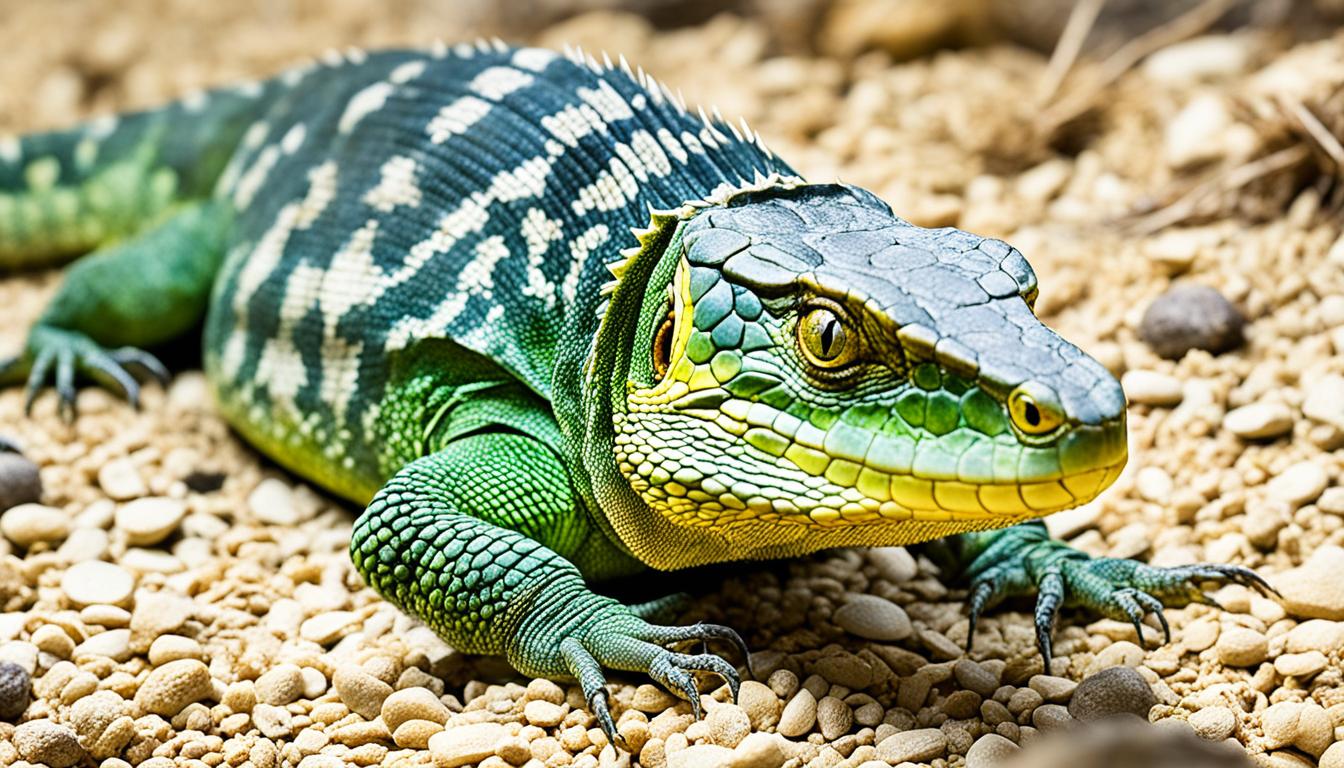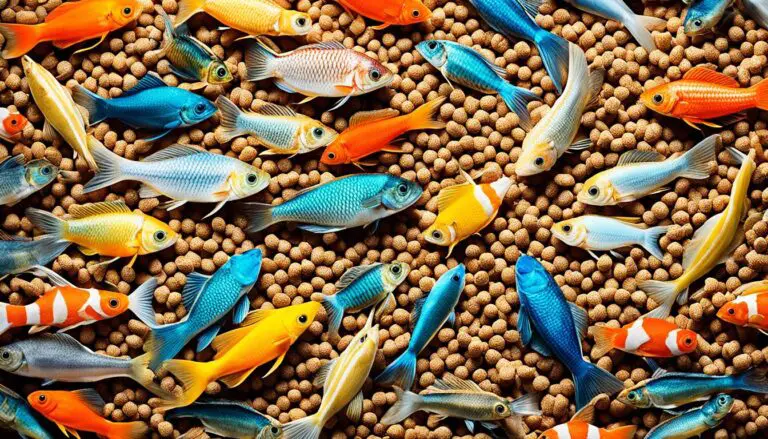Nutritional Secondary Hyperparathyroidism in Reptiles
Nutritional secondary hyperparathyroidism, or NSHP, is a big problem for pet reptiles. It’s also called metabolic bone disease.
This issue comes from not getting enough calcium. It happens when the calcium to phosphorus balance in food is off. Also, not enough UVB light and bad care contribute. This sickness makes bones soft and breaks them, which can kill the reptile. Lizards, turtles, and tortoises are often affected, especially the young ones and those that are breeding.
If you have or like reptiles, it’s very important to know about NSHP. You should learn the signs, how to treat it, and most importantly, how to prevent it. This keeps your reptile friends healthy and happy.
Key Takeaways
- Nutritional Secondary Hyperparathyroidism (NSHP) is a common and serious health problem in pet reptiles.
- NSHP is caused by inadequate calcium intake, an imbalance of calcium and phosphorus in the diet, lack of UVB lighting, and poor husbandry practices.
- Common symptoms of NSHP in reptiles include swollen hind legs, misshaped shells, spinal deviations, tremors, and difficulty in walking or eating.
- Reptiles with NSHP may require treatment such as oral calcium supplementation, calcium injections, vitamin D3 injections, and calcium-rich diets.
- Preventive measures, including proper nutrition, UVB lighting, and regular veterinary care, play a vital role in preventing NSHP in reptiles.
Causes of Nutritional Secondary Hyperparathyroidism in Reptiles
Nutritional Secondary Hyperparathyroidism (NSHP) in reptiles comes from not getting enough calcium or vitamin D. This can happen when reptiles don’t eat the right foods or get enough sunlight. It’s important to know these causes to keep pet reptiles healthy.
Insufficient Calcium in the Diet
Not eating enough calcium is a key reason reptiles develop NSHP. Calcium is vital for their bones and muscles. Since many reptile diets lack calcium, especially those that eat bugs or plants, they can have weak bones over time.
High Phosphorus Intake
Eating too much phosphorus, found in insects and plants, is bad for reptiles too. If the diet is high in phosphorus but low in calcium, their bodies can’t use the calcium right. This messes up their bone health and can cause NSHP symptoms.
Inadequate Exposure to UVB Lighting
UVB light helps reptiles make vitamin D3, essential for calcium use. Without enough UVB light, reptiles can’t get the vitamin D they need. This leads to problems with using calcium, causing NSHP. So, it’s really important to give reptiles the right UVB light.
Improper Cage Temperatures
If a reptile’s home is too cold, it affects their calcium use. They rely on the right temperature to digest food and stay healthy. Bad temperatures can make them not absorb calcium properly, which leads to NSHP risk.

NSHP in reptiles is often caused by not having enough calcium or vitamin D, an unbalanced diet, and not getting the right UVB light. The solution is in providing the right foods, enough UVB light, and keeping their environment warm. This is key for pet reptiles to stay healthy and happy.
Symptoms and Diagnosis of Nutritional Secondary Hyperparathyroidism in Reptiles
Understanding the symptoms of Nutritional Secondary Hyperparathyroidism (NSHP) in reptiles is very important. It helps in early treatment. Reptiles with NSHP might show signs like troubled movements and weak bones.
- Swollen hind legs: Reptiles may notice swelling in their hind legs, making it hard for them to walk or carry their weight.
- Misshaped shells: Tortoises and turtles could have odd shell shapes like pyramiding or pitting.
- Spinal deviations: Spines in some reptiles might curve, showing spinal problems.
- Tremors: Muscles might shake with tremors or spasms, which are alarming.
- Difficulty in walking or eating: Eating and moving may become hard for reptiles with NSHP. This can affect their life activities and food intake.
If you see these signs in your reptile, get vet care fast. A reptile vet will deeply check your pet with tests to find NSHP and why it happened.
“Starting care early makes a big difference in handling Nutritional Secondary Hyperparathyroidism in reptiles. Fast vet care stops the disease from getting worse and raises the reptile’s health.”
Diagnosing NSHP includes knowing what the reptile eats and how it’s cared for. The vet will ask about its food, sunlight, and care. They will check bones and for any pain.
Blood tests look into calcium and phosphorus levels. These can tell if NSHP is the issue. Also, X-rays can show bone condition and how treatment is doing.
Early diagnosis and the right vet care are vital for the reptile’s health.

Veterinary Care for Reptiles: Monitoring and Treatment
Reptiles need special care from vets for good health, especially against NSHP. Visiting a reptile vet regularly is key to watch and tweak treatment to avoid setbacks.
- Regular check-ups: Visiting the vet regularly can catch NSHP or health problems early. The vet will see how the reptile is doing and give care tips.
- Medication and supplementation: Your reptile might get calcium supplements, vitamin D3 shots, or other drugs to fix imbalances and help bones.
- Dietary recommendations: The vet will suggest the right diet to ensure the reptile gets enough calcium and nutrients for top health.
- UVB lighting: Good UVB light helps reptiles make vitamin D3 and take in calcium. The vet can help set up the best UVB light for the reptile.
Proper veterinary care is vital for reptile health. It means the right diagnosis, treatment, and support. Regular vet visits and keeping in touch with your reptile vet are essential for caring for your reptile.
Treatment of Nutritional Secondary Hyperparathyroidism in Reptiles
Most reptiles with Nutritional Secondary Hyperparathyroidism (NSHP) get better with a good treatment plan. The main aim is to fix low calcium levels and help bones get strong again. Here are some ways to treat NSHP in reptiles:
- Oral calcium supplementation: Pet owners give calcium supplements by mouth. This ensures the reptile gets enough calcium. It helps keep calcium levels right and bones healthy.
- Calcium injections: For worse cases, a vet might give calcium shots. This boosts the reptile’s calcium fast, which helps their bones heal.
- Vitamin D3 injections: If a reptile with NSHP is low on vitamin D3, they’ll get shots. This vitamin is important for using calcium right. Shots help the animal’s body handle calcium well.
- Calcium-rich diets: Sometimes the reptile’s food needs a change to add more calcium. This balances calcium and supports good bone growth. They might get foods with extra calcium, like certain insects, or plants treated with calcium.
NSHP leading to broken bones might need further steps.
- Pain medication: Eases pain and discomfort from fractures.
- Setting, splinting, or surgery: Fixing bone breaks could mean surgery. Or, the vet may just need to hold the bone still to help it heal right.
Reptiles having trouble with bowel movements might need warm water soaks. Or, they might need enemas for constipation. These help get their digestion back to normal.
It’s crucial to keep up with check-ups and X-rays during treatment. These visits let the vet see how the reptile is doing. They can make changes to treatment as necessary, ensuring the reptile gets better. Providing the right medical care is key to helping a reptile beat NSHP and thrive.
| Treatment Options | Benefits |
|---|---|
| Oral calcium supplementation | Ensures adequate calcium intake and promotes skeletal health |
| Calcium injections | Rapidly increases calcium levels and supports bone healing |
| Vitamin D3 injections | Replenishes vitamin D3 levels for proper calcium absorption |
| Calcium-rich diets | Restores calcium balance and supports healthy bone growth |
“Proper treatment of Nutritional Secondary Hyperparathyroidism in reptiles involves a combination of oral and injectable calcium supplementation, vitamin D3 administration, and calcium-rich diets. Regular veterinary check-ups, X-rays, and additional measures like pain medication or splinting are crucial for successful management and recovery.” – Dr. Rebecca Smith, Veterinary Specialist
Prevention of Nutritional Secondary Hyperparathyroidism in Reptiles
To prevent Nutritional Secondary Hyperparathyroidism (NSHP) in reptiles, focus on their diet and living conditions. A diet rich in calcium and the right calcium-phosphorus balance is key. For insect-eating reptiles, feed them insects full of nutrients. Ensure plant-eating reptiles get enough calcium from various veggies.
It’s vital to have UVB lighting for reptiles. This light helps them make vitamin D3 and absorb calcium. Make sure your reptiles’ living space meets their UVB needs to prevent NSHP.
Keeping the right environment for reptiles is crucial too. They need the correct temperatures, enough water, and low stress. With careful habitat design and regular checks, you can lower the NSHP risk for your pets.

“Proper nutrition, UVB lighting, and thoughtful husbandry practices are key to preventing Nutritional Secondary Hyperparathyroidism in reptiles. By offering a balanced diet with the right calcium-phosphorus ratio, ensuring UVB exposure, and maintaining optimal habitat conditions, reptile owners can play an active role in keeping their pets healthy and preventing this common health issue.”
Importance of Regular Veterinary Care for Reptiles
Getting regular check-ups from a vet is vital for a reptile’s health. Preventive care from a reptile vet keeps them in good shape. These visits help catch health issues early, like NSHP, a serious condition.
Reptile veterinarians also know a lot about what these pets need to eat and their environment. They can help figure out the best food, keep the cage at the right temperature, and design a good space for the reptile. This advice is crucial for the reptile’s health.
Reptile vets are trained to find and treat NSHP. They check the reptile’s health, do tests to see its calcium levels, and might take X-rays. All of this helps see if the treatment is working.
Seeing the vet regularly also keeps the owners up-to-date with new reptile care info. Vets offer the latest treatments and tips that can make reptiles’ lives better.
Regular veterinary care is key for reptiles. It includes check-ups and looking out for health issues like NSHP. Early detection saves lives.
Reptiles are good at hiding when they’re sick, which makes vet visits very important. Waiting for signs of illness to show can be dangerous. Early vet care makes it much easier to treat most health problems.
Benefits of regular veterinary care for reptiles:
- Early detection and prevention of potential health problems.
- Expert guidance on reptile nutrition, husbandry, and UVB lighting requirements.
- Diagnosis and treatment of nutritional secondary hyperparathyroidism (NSHP).
- Access to the latest advancements in reptile health care.
- Improved overall well-being and longevity of reptiles.
Reptiles should be cared for just like any other pet. Vets are a crucial part of taking good care of them. With regular check-ups, they can thrive and be healthy.

| Benefits of Regular Veterinary Care for Reptiles | Details |
|---|---|
| Early detection and prevention of potential health problems | Regular check-ups can identify health issues before they become severe. |
| Expert guidance on reptile nutrition, husbandry, and UVB lighting requirements | Reptile veterinarians offer valuable advice on providing a balanced diet and creating a suitable habitat. |
| Diagnosis and treatment of nutritional secondary hyperparathyroidism (NSHP) | Reptile veterinarians have the knowledge and skills to diagnose and treat NSHP. |
| Access to the latest advancements in reptile health care | Veterinarians can provide information on new treatment options and preventive measures. |
| Improved overall well-being and longevity of reptiles | Regular care ensures a higher quality of life for reptiles. |
The Role of Calcium and UVB Lighting in Reptile Health
Reptile health depends a lot on two things: calcium and UVB lighting. Calcium is crucial for bone growth, muscle work, and metabolism. With the right diet, reptiles get the calcium they need to grow strong.
But, to use this calcium, reptiles need UVB light too. UVB helps make vitamin D3 in their skin. And this vitamin is key for absorbing and using calcium. Without enough UVB, reptiles can get sick from lack of vitamin D3.
Good care for reptiles involves making sure they get both calcium and UVB light. Providing them with a space that has enough UVB light is important. Special light bulbs for reptiles can do this job well, making the right kind of UVB for vitamin D3.
Reptiles need both calcium and UVB light for good health. If they lack these, they might get sick. Good care includes proper UVB lights and a diet rich in calcium.
Feeding reptiles a mix of foods that are high in calcium is also important. They can eat insects, fruits, or veggies. But it’s crucial to choose foods that fit the reptile’s species and diet needs.
Looking after your reptile’s diet and living conditions is key to their health. Knowing about calcium and UVB light is vital for keeping your pet healthy. It helps them avoid issues from not getting enough calcium and vitamin D3.
Benefits of Calcium and UVB Lighting for Reptiles:
- Promotes proper bone growth and development
- Maintains muscle function and overall metabolic processes
- Supports calcium absorption and utilization
- Prevents calcium deficiencies and related health complications
Calcium-Rich Foods for Reptiles
| Food | Calcium Content (per 100g) |
|---|---|
| Kale | 150mg |
| Collard Greens | 200mg |
| Turnip Greens | 190mg |
| Mustard Greens | 165mg |
| Butternut Squash | 30mg |
Note: The calcium content may vary between individual food items and may not be suitable for all reptile species. Always consult with a reptile veterinarian or trusted expert to determine the best diet for your specific reptile.
Management of Nutritional Secondary Hyperparathyroidism in Reptiles
When it comes to Nutritional Secondary Hyperparathyroidism (NSHP) in reptiles, a full approach is needed. It must tackle the causes and offer the right care for recovery. This includes fixing diet issues, giving the right calcium, making sure there’s good UVB light, and helping weak reptiles.
It’s very important to find and fix any diet or care issues that led to NSHP. Reptile owners should team up with a vet. Together, they can create a diet with enough calcium and the right balance of nutrients. Sometimes, reptiles need extra calcium through supplements.
Reptiles need UVB light to convert vitamin D3, key for absorbing calcium. Their living spaces should have good UVB light to get enough sun.
Helping weak reptiles with NSHP is also crucial. This can involve medicine for pain, like from fractures. Techniques like splinting and bandaging can help broken bones heal. Keeping their environment calm and their care correct is also very important.
Seeing the vet regularly is key to track the reptile’s recovery. This care ensures their health for the long run. During check-ups, the vet will see if the treatments are working. They will also look at any new issues that came up.
Example Table: Comparison of Management Strategies for NSHP in Reptiles
| Treatment Approach | Key Features |
|---|---|
| Diet Correction | Developing a nutritionally balanced diet with adequate calcium and a proper calcium-phosphorus ratio |
| Calcium Supplementation | Providing calcium supplements as needed to support calcium metabolism |
| UVB Lighting | Ensuring reptiles receive adequate UVB exposure for vitamin D3 synthesis and calcium absorption |
| Supportive Care | Offering pain medication, immobilization techniques, and stress reduction measures |
| Regular Veterinary Follow-ups | Monitoring progress, adjusting treatment plans, and addressing new concerns |
By following a detailed care plan, those looking after reptiles can successfully manage NSHP. This improves the health and happiness of the reptiles they care for.
Impact of NSHP on Reptile Well-being and Long-term Management
Reptiles with Nutritional Secondary Hyperparathyroidism (NSHP) face big health issues. Their quality of life and well-being suffer a lot. To help them, we must use long-term strategies. These aim to keep their health on track and avoid problems with their bones.
For these reptiles, it’s key to keep up with calcium, UVB, and watch their food and living conditions closely. This helps their health stay good. Also, regular vet visits and X-rays can help a lot. They let us see how the treatment is going and if our reptile needs more help.
Overall, caring for a reptile with NSHP needs a lot of attention. If we are careful and do what’s best for them, their life can be much better. This includes following the vet’s advice and taking care of them well every day.
Conclusion
Nutritional Secondary Hyperparathyroidism, also known as metabolic bone disease, is very common among pet reptiles. It is caused by low calcium, poor diet, lack of UVB light, and bad husbandry. Finding it early and treating it is key to helping reptiles lead healthy lives.
To stop Nutritional Secondary Hyperparathyroidism, there are steps to follow. Make sure reptiles get the right food, plenty of UVB light, and see the vet often. These efforts by the owners lower the danger of metabolic bone disease and make reptiles healthier and happier.
Overall, caring for reptiles is essential to keep them from getting sick. A good diet, enough UVB light, and regular vet visits are crucial. With knowledge about Nutritional Secondary Hyperparathyroidism, reptile owners can offer the best care. This way, their reptile friends will be joyful and well.
FAQ
What is Nutritional Secondary Hyperparathyroidism?
What are the causes of Nutritional Secondary Hyperparathyroidism in reptiles?
What are the symptoms and how is Nutritional Secondary Hyperparathyroidism in reptiles diagnosed?
How is Nutritional Secondary Hyperparathyroidism in reptiles treated?
How can Nutritional Secondary Hyperparathyroidism in reptiles be prevented?
Why is regular veterinary care important for reptiles?
What is the role of calcium and UVB lighting in reptile health?
How is Nutritional Secondary Hyperparathyroidism in reptiles managed?
What is the impact of NSHP on reptile well-being and long-term management?
What are the key takeaways about Nutritional Secondary Hyperparathyroidism in reptiles?
Source Links
- https://veterinarypartner.vin.com/default.aspx?pid=19239&catId=102919&id=8012396
- https://azeah.com/reptiles-amphibians-lizards-tortoises-turtles/nutritional-secondary-hyperparathyroidism-metabolic
- http://vetfolio-vetstreet.s3.amazonaws.com/dc/9f08001a2811e29e50005056ad4736/file/VT1112_Avila-Guevara_CE.pdf
Peter Stones is the founder of Exotic Pets Place, the leading online resource for exotic pet care information.
With over 10 years of hands-on exotic pet ownership experience, he is deeply passionate about sharing his expertise to help others properly care for their unusual pets.
When he's not writing extensively researched articles or connecting with fellow exotic pet enthusiasts worldwide, you can find Peter at home tending to his own beloved menagerie of exotic animals.







